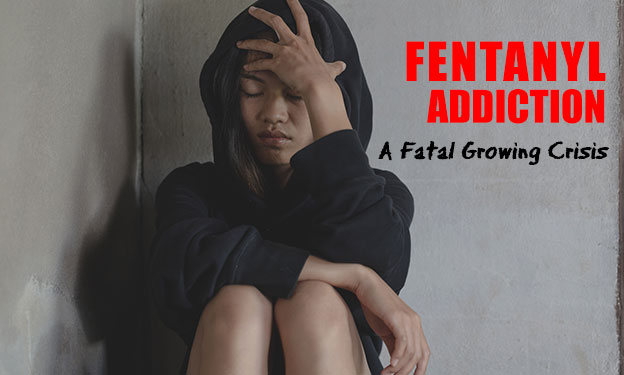In a shocking revelation from the latest data by the US Centers for Disease Control and Prevention, the United States has seen an unprecedented surge in drug overdose deaths, with more than 111,000 fatalities in the 12-month period ending in April 2023. This alarming number sets a new and tragic record, underscoring the relentless grip of the drug epidemic, with fentanyl addiction at its epicenter. The pervasiveness of fentanyl, a synthetic opioid nearly 70% implicated in these overdose deaths, paints a harrowing picture of the crisis we face.
Fentanyl addiction is not just a health issue; it’s a crisis that touches every corner of society. As we grapple with these daunting challenges, it becomes increasingly clear that a multifaceted approach involving prevention, treatment, and education is essential to turn the tide against this devastating epidemic.
The Rising Threat of Fentanyl in the Opioid Epidemic: COVID-19, Isolation, Mental Health Crisis, and Unprotected Borders
The opioid epidemic, already a significant public health concern, has been greatly exacerbated by the advent of COVID-19, leading to an unprecedented rise in the misuse of synthetic opioids like fentanyl.
The pandemic, with its long periods of isolation and widespread mental health crises, has created a perfect storm for the escalation of substance abuse disorders. Isolation, a direct consequence of lockdowns and social distancing measures, has not only increased feelings of loneliness and anxiety but also disrupted the support networks crucial for those struggling with addiction.
For over 25 years, people from all over the world have chosen Waismann Method as their opioid detox provider.
We know the challenges you face and the importance of creating a unique and personal experience for you right from the start.Call for Detox Options 1-800-423-2482
“Fentanyl is the single deadliest drug threat our nation has ever encountered. Fentanyl is everywhere. From large metropolitan areas to rural America, no community is safe from this poison. We must take every opportunity to spread the word to prevent fentanyl-related overdose death and poisonings from claiming scores of American lives every day.”
– Anne Milgram, DEA Administrator
The Role of Mental Health in Opioid Addiction
The mental health crisis, fueled by the pandemic, has seen a marked increase in cases of depression, anxiety, and other mental health disorders. These conditions often intertwine with substance abuse, as individuals turn to drugs like fentanyl as a form of self-medication. The potency and accessibility of fentanyl have made it a drug of choice for many, significantly increasing the risk of overdose and death.
Compounding this issue is the challenge of unprotected borders. The illicit trafficking of fentanyl, primarily manufactured overseas, has found an easy entry through these vulnerable points. The lack of stringent border control measures has facilitated the influx of fentanyl into the domestic drug market, making it readily available to those susceptible to opioid addiction.
Opioid Crisis Geography: A Nationwide Concern
The combination of these factors – the psychological impacts of COVID-19, increased isolation, a burgeoning mental health crisis, and the ease of drug trafficking through unprotected borders – has fueled the surge in fentanyl misuse. This alarming trend underscores the need for a holistic approach to the opioid epidemic, one that addresses not only the physical aspects of addiction but also the underlying mental health issues and includes stronger measures to control the illegal drug supply. Without addressing these interconnected factors, the battle against the rising threat of fentanyl in the opioid epidemic will remain an uphill struggle.
The healthcare system, crucial in addressing the fentanyl crisis, is currently grappling with significant challenges in providing accessible and expert-led mental health care and addiction treatment. The increasing demand for these services highlights a gap in the availability of treatment facilities managed by medical professionals, rather than relying solely on the experiences of ex-patients.
- Urgent Need for Professional Medical Care The intricate nature of fentanyl addiction, deeply interlinked with mental health issues, requires treatment overseen by qualified healthcare professionals. These experts, including psychiatrists, psychologists, and addiction specialists, bring essential clinical experience and knowledge crucial for effectively addressing the complex dimensions of addiction.
- Expanding Access to Treatment Centers with Professional Staff There is a pressing need to increase the number of treatment centers that specialize in medical detoxification and mental health care. These centers should be equipped with trained medical staff capable of delivering comprehensive and evidence-based treatment approaches.
- Enhancing Insurance Coverage for Addiction and Mental Health Treatment Improving insurance coverage for addiction and mental health treatments is vital. Many current insurance policies do not adequately cover the extent of care necessary for effective treatment and recovery. More inclusive insurance plans would make professional medical care more accessible to a broader population, ensuring those in need can receive the necessary support.
- Prioritizing Medical Care over Peer-Led Models While peer support can play a supportive role in the recovery process, it should complement, not replace, professional medical treatment. Professional care is essential for the accurate diagnosis and treatment of co-occurring mental health conditions often associated with addiction. This approach ensures that patients receive comprehensive care, crucial for effective recovery and prevention of relapse.
To effectively counter the fentanyl crisis, it is imperative that the healthcare system places a stronger emphasis on professional mental health care and addiction treatment. By expanding professional treatment facilities, enhancing insurance coverage, and prioritizing expert-led care, we can offer more effective and comprehensive treatment for those battling addiction and its associated mental health challenges.
“The fentanyl overdose epidemic ravages our communities with a fury that outpaces our grimmest statistics, claiming lives at a heart-wrenching pace. The numbers we have barely scratch the surface of the ongoing tragedy that unfolds daily; the scale of loss is beyond comprehension.
Together, we possess the power to forge a path of hope and healing. We are capable of rising to this challenge, of turning the tide against this crisis with determination and collective action. Let us not underestimate our potential to make a significant difference; for in the face of adversity, we can, and we must, do better.”
– Clare Waismann M-RAS/ SUDCC II
Sources:
- Fentanyl & Opioid Overdose Prevention
- Fentanyl Crisis and Intervention
- The Border and Fentanyl Crises Put Our Communities at Risk
- DEA – Fighting the Flow from the Southwest Border
This article, authored and reviewed by Clare Waismann, M-RAS, SUDCC II, Founder of Waismann Method Advanced Treatment for Opiate Dependence, is for informational purposes only and should not be considered medical advice or a recommendation. Consult a healthcare professional for guidance and treatment options. While we strive to maintain high editorial standards, please be aware that information may become outdated. Waismann Method, its employees, agents, and associated individuals are not liable for any errors, omissions, or consequences resulting from the use of the information provided.






